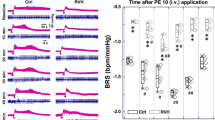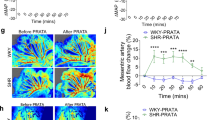Abstract
Mechanosensitive cation channels such as Piezo1 and Piezo2 are activated by mechanical force like a starched wall of the aorta while blood pressure (BP) rising, which helps to elucidate the underlying mechanism of mechanotransduction of baroreceptor endings. In this study we investigated how Piezo1 channel activation-mediated gender- and afferent-specific BP regulation in rats. We established high-fat diet and fructose drink-induced hypertension model rats (HFD-HTN) and deoxycorticosterone (DOCA)-sensitive hypertension model rats. We showed that the expression levels of Piezo1 and Piezo2 were significantly up-regulated in left ventricle of HFD and DOCA hypertensive rats, whereas the down-regulation of Piezo1 was likely to be compensated by Piezo2 up-regulation in the aorta. Likewise, down-regulated Piezo1 was observed in the nodose ganglion (NG), while up-regulated Piezo2 was found in the nucleus tractus solitarius (NTS), which might synergistically reduce the excitatory neurotransmitter release from the presynaptic membrane. Notably, microinjection of Yoda1 (0.025–2.5 mg/ml) into the NG concentration-dependently reduced BP in both hypertensive rat models as well as in control rats with similar EC50; the effect of Yoda1 was abolished by microinjection of a Piezo1 antagonist GsMTx4 (1.0 μM). Functional analysis in an in vitro aortic arch preparation showed that instantaneous firing frequency of single Ah-fiber of aortic depressor nerve was dramatically increased by Yoda1 (0.03–1.0 μM) and blocked by GsMTx4 (1.0 μM). Moreover, spontaneous synaptic currents recorded from identified 2nd-order Ah-type baroreceptive neurons in the NTS was also facilitated over 100% by Yoda1 (1.0 μM) and completely blocked by GsMTx4 (3.0 μM). These results demonstrate that Piezo1 expressed on Ah-type baroreceptor and baroreceptive neurons in the NG and NTS plays a key role in a sexual-dimorphic BP regulation under physiological and hypertensive condition through facilitation of baroreflex afferent neurotransmission, which is presumably collaborated by Piezo2 expression at different level of baroreflex afferent pathway via compensatory and synergistic mechanisms.
This is a preview of subscription content, access via your institution
Access options
Subscribe to this journal
Receive 12 print issues and online access
$259.00 per year
only $21.58 per issue
Buy this article
- Purchase on Springer Link
- Instant access to full article PDF
Prices may be subject to local taxes which are calculated during checkout






Similar content being viewed by others
References
Coste B, Mathur J, Schmidt M, Earley TJ, Ranade S, Petrus MJ, et al. Piezo1 and Piezo2 are essential components of distinct mechanically activated cation channels. Science. 2010;330:55–60.
Li J, Hou B, Tumova S, Muraki K, Bruns A, Ludlow MJ, et al. Piezo1 integration of vascular architecture with physiological force. Nature. 2014;515:279–82.
Ranade SS, Qiu Z, Woo SH, Hur SS, Murthy SE, Cahalan SM, et al. Piezo1, a mechanically activated ion channel, is required for vascular development in mice. Proc Natl Acad Sci USA. 2014;111:10347–52.
Kim M, Heo G, Kim SY. Neural signalling of gut mechanosensation in ingestive and digestive processes. Nat Rev Neurosci. 2022;23:135–56.
Thumshirn M, Camilleri M, Hanson RB, Williams DE, Schei AJ, Kammer PP. Gastric mechanosensory and lower esophageal sphincter function in rumination syndrome. Am J Physiol. 1998;275:G314–21.
Retailleau K, Duprat F, Arhatte M, Ranada SS, Peyronnet R, Martins JR, et al. Piezo1 in smooth muscle cells is involved in hypertension-dependent arterial remodeling. Cell Rep. 2015;13:1161–71.
Rode B, Shi J, Endesh N, Drinkhill M, Webster PJ, Lotteau SJ, et al. Piezo1 channels sense whole body physical activity to reset cardiovascular homeostasis and enhance performance. Nat Commun. 2017;8:350.
Morris CE, Juranka PF. Nav channel mechanosensitivity: activation and inactivation accelerate reversibly with stretch. Biophys J. 2007;93:822–33.
Blasius AL, Dubin AE, Petrus MJ, Lim BK, Narezkina A, Criado JR, et al. Hypermorphic mutation of the voltage-gated sodium channel encoding gene Scn10a causes a dramatic stimulus-dependent neurobehavioral phenotype. Proc Natl Acad Sci USA. 2011;108:19413–8.
Koser D, Thompson AJ, Foster SK, Dwivedy A, Pillai EK, Sheridan GK, et al. Mechanosensing is critical for axon growth in the developing brain. Nat Neurosci. 2016;19:1592–98.
Zhu LY, Liu C, Li ZR, Niu C, Wu J. NLRP3 deficiency did not attenuate NASH development under high fat calorie diet plus high fructose and glucose in drinking water. Lab Invest. 2021;101:588–99.
Morgan BJ. Vascular consequences of intermittent hypoxia. Adv Exp Med Biol. 2007;618:69–84.
Nautiyal M, Shaltout HA, Chappell M, Diz DI. Comparison of candesartan and angiotensin-(1-7) combination to mito-TEMPO treatment for normalizing blood pressure and sympathovagal balance in (mREN2)27 rats. J Cardiovasc Pharmacol. 2019;73:143–8.
Wang S, Chennupati R, Kaur H, Iring A, Wettschureck N, Offermanns S. Endothelial cation channel Piezo1 controls blood pressure by mediating flow-induced ATP release. J Clin Invest. 2016;126:4527–36.
Lima TDR, Voltarelli FA, Freire LS, da Silva FA, Almeida PC, Avila ETP, et al. High-fat diet and fructose drink introduced after weaning rats, induces a better human obesity model than very high-fat diet. J Food Biochem. 2021;45:e13671.
Wang D, Luo Y, Myakala K, Orlicky DJ, Dobrinskikh E, Wang X, et al. Serelaxin improves cardiac and renal function in DOCA-salt hypertensive rats. Sci Rep. 2017;7:9793.
Chen P, Xu B, Feng Y, Li KX, Liu Z, Sun X, et al. FGF-21 ameliorates essential hypertension of SHR via baroreflex afferent function. Brain Res Bull. 2020;154:9–20.
Yuan M, Ma MN, Wang TY, Feng Y, Chen P, He C, et al. Direct activation of tachykinin receptors within baroreflex afferent pathway and neurocontrol of blood pressure regulation. CNS Neurosci Ther. 2019;25:123–35.
Feng B, Li BY, Nauman EA, Schild JH. Theoretical and electrophysiological evidence for axial loading about aortic baroreceptor nerve terminals in rats. Am J Physiol Heart Circ Physiol. 2007;293:H3659–72.
Jin YH, Bailey TW, Li BY, Schild JH, Andresen MC. Purinergic and vanilloid receptor activation releases glutamate from separate cranial afferent terminals in nucleus tractus solitarius. J Neurosci. 2004;24:4709–17.
Lu XL, Xu WX, Yan ZY, Qian Z, Xu B, Liu Y, et al. Subtype identification in acutely dissociated rat nodose ganglion neurons based on morphologic parameters. Int J Biol Sci. 2013;9:716–27.
Zhang YY, Yan ZY, Qu MY, Guo XJ, Li G, Lu XL, et al. KCa1.1 is potential marker for distinguishing Ah-type baroreceptor neurons in NTS and contributes to sex-specific presynaptic neurotransmission in baroreflex afferent pathway. Neurosci Lett. 2015;604:1–6.
Wu D, Zhao D, Huang D, Sun X, Li KX, Feng Y, et al. Estrogen-dependent depressor response of melatonin via baroreflex afferent function and intensification of PKC-mediated Na(v)1.9 activation. Acta Pharmacol Sin. 2022;43:2313–24.
Li BY, Schild JH. Patch clamp electrophysiology in nodose ganglia of adult rat. J Neurosci Methods. 2002;115:157–67.
Li BY, Schild JH. Electrophysiological and pharmacological validation of vagal afferent fiber type of neurons enzymatically isolated from rat nodose ganglia. J Neurosci Methods. 2007;164:75–85.
Li BY, Qiao GF, Feng B, Zhao RB, Lu YJ, Schild JH. Electrophysiological and neuroanatomical evidence of sexual dimorphism in aortic baroreceptor and vagal afferents in rat. Am J Physiol Regul Integr Comp Physiol. 2008;295:R1301–10.
Qiao GF, Li BY, Lu YJ, Fu YL, Schild JH. 17Beta-estradiol restores excitability of a sexually dimorphic subset of myelinated vagal afferents in ovariectomized rats. Am J Physiol Cell Physiol. 2009;297:C654–64.
Xu WX, Yu JL, Feng Y, Yan QX, Li XY, Li Y, et al. Spontaneous activities in baroreflex afferent pathway contribute dominant role in parasympathetic neurocontrol of blood pressure regulation. CNS Neurosci Ther. 2018;24:1219–30.
Li Y, Feng Y, Liu L, Li X, Li XY, Sun X, et al. The baroreflex afferent pathway plays a critical role in H2S-mediated autonomic control of blood pressure regulation under physiological and hypertensive conditions. Acta Pharmacol Sin. 2021;42:898–908.
Liu Y, Zhao SY, Feng Y, Sun J, Lu XL, Yan QX, et al. Contribution of baroreflex afferent pathway to NPY-mediated regulation of blood pressure in rats. Neurosci Bull. 2020;36:396–406.
Liu Y, Zhou JY, Zhou YH, Wu D, He JL, Han LM, et al. Unique expression of angiotensin type-2 receptor in sex-specific distribution of myelinated Ah-type baroreceptor neuron contributing to sex-dimorphic neurocontrol of circulation. Hypertension. 2016;67:783–91.
Piotrowski R, Baran J, Sikorska A, Krynski T, Kulakowski P. Cardioneuroablation for reflex syncope: efficacy and effects on autonomic cardiac regulation-a prospective randomized trial. JACC Clin Electrophysiol. 2023;9:85–95.
Shvachiy L, Amaro-Lead A, Outeiro TF, Rocha I, Geraldes V. Intermittent lead exposure induces behavioral and cardiovascular alterations associated with neuroinflammation. Cells. 2023;12:818.
Yugar LBT, Yugar-Toledo JC, Dinamarco N, Sedenho-Prado LG, Moreno BVD, Rubio TA, et al. The role of heart rate variability (HRV) in different hypertensive syndromes. Diagnostics. 2023;13:785.
Grosu L, Grosu AI, Crisan D, Zlibut A, Perju-Dumbrava L. Parkinson’s disease and cardiovascular involvement: edifying insights (Review). Biomed Rep. 2023;18:25.
de Andrade PE, Zangirolami-Raimundo J, Morais TC, de Abreu LC, Siqueira CE, SorpresoI CE, et al. Cardiac behavior and heart rate variability in elderly hypertensive individuals during aerobic exercise: a non-randomized controlled study. Int J Environ Res Public Health. 2023;20:1292.
Rossel W. Reflex regulation of the frog heart by pressoreceptors in the posterior extremital circulation. Pflug Arch Gesamt Physiol Menschen Tiere. 1950;253:55–8.
Wang L, You X, Lotinum S, Zhang L, Wu N, Zou W, et al. Mechanical sensing protein PIEZO1 regulates bone homeostasis via osteoblast-osteoclast crosstalk. Nat Commun. 2020;11:282.
Atcha H, Jairaman A, Holt JR, Meli VS, Nagalla RR, Veerasubramanian PK, et al. Mechanically activated ion channel Piezo1 modulates macrophage polarization and stiffness sensing. Nat Commun. 2021;12:3256.
Solis AG, Bielecki P, Steach HR, Sharma L, Harman CCD, Yun S, et al. Mechanosensation of cyclical force by Piezo1 is essential for innate immunity. Nature. 2019;573:69–74.
Victor RG. Carotid baroreflex activation therapy for resistant hypertension. Nat Rev Cardiol. 2015;12:451–63.
Wang LQ, Qian Z, Ma HL, Zhou M, Li HD, Cui CP, et al. Estrogen-dependent KCa1.1 modulation is essential for retaining neuroexcitation of female-specific subpopulation of myelinated Ah-type baroreceptor neurons in rats. Acta Pharmacol Sin. 2021;42:2173–80.
Kim JS, Kirkland RA, Lee SH, Cawthon CR, Rzepka KW, Minaya DM, et al. Gut microbiota composition modulates inflammation and structure of the vagal afferent pathway. Physiol Behav. 2020;225:113082.
Feng Y, Liu Y, Cao PX, Sun X, Li KX, Li XY, et al. Estrogen-dependent MicroRNA-504 expression and related baroreflex afferent neuroexcitation via negative regulation on KCNMB4 and KCa1.1 β4-subunit expression. Neuroscience. 2020;442:168–82.
Santa Cruz Chavez GC, Li BY, Glazebrook PA, Kunze DL, Schild JH. An afferent explanation for sexual dimorphism in the aortic baroreflex of rat. Am J Physiol Heart Circ Physiol. 2014;307:H910–21.
Li BY, Schild JH. Persistent tetrodotoxin-resistant Na+ currents are activated by prostaglandin E2 via cyclic AMP-dependent pathway in C-type nodose neurons of adult rats. Biochem Biophys Res Commun. 2007;355:1064–8.
Liu Y, Wen X, Liu SZ, Song DX, Wu D, Gaun J, et al. KCa1.1-mediated frequency-dependent central and peripheral neuromodulation via Ah-type baroreceptor neurons located within nodose ganglia and nucleus of solitary tract of female rats. Int J Cardiol. 2015;185:84–7.
Li JN, Lu XL, He JL, Wang JX, Zhao M, Liang XB, et al. Sex- and afferent-specific differences in histamine receptor expression in vagal afferents of rats: a potential mechanism for sexual dimorphism in prevalence and severity of asthma. Neuroscience. 2015;303:166–77.
Acknowledgements
This project was supported by the National Natural Science Foundation of China 81971326 and 81573431 to BYL; 82204387 to DW.
Author information
Authors and Affiliations
Corresponding author
Ethics declarations
Competing interests
The authors declare no competing interests.
Supplementary information
Rights and permissions
Springer Nature or its licensor (e.g. a society or other partner) holds exclusive rights to this article under a publishing agreement with the author(s) or other rightsholder(s); author self-archiving of the accepted manuscript version of this article is solely governed by the terms of such publishing agreement and applicable law.
About this article
Cite this article
Cui, Cp., Xiong, X., Zhao, Jx. et al. Piezo1 channel activation facilitates baroreflex afferent neurotransmission with subsequent blood pressure reduction in control and hypertension rats. Acta Pharmacol Sin 45, 76–86 (2024). https://doi.org/10.1038/s41401-023-01154-y
Received:
Accepted:
Published:
Issue Date:
DOI: https://doi.org/10.1038/s41401-023-01154-y



